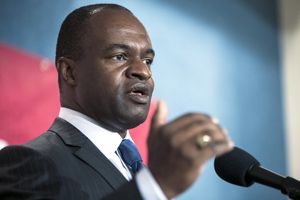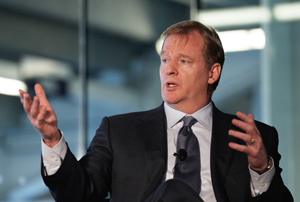The NFL and NFLPA may have nine more years of labor peace by virtue of the collective-bargaining agreement the sides signed 13 months ago, but it is a bitter cold peace that’s left many initiatives dead on arrival.
Whether it’s HGH testing, extending the trade deadline by two weeks, requiring players to wear kneepads, or tweaking the injured reserve system, proposals die in the maw of the union-league strain.
Throw in the big-picture vitriol, from Bountygate to a union collusion claim demanding billions of dollars in compensation, and the picture is one of a league and union that will battle the big and the small for the foreseeable future.
“The NFLPA is constantly going to be an advocate for the players; to think it will be absolutely smooth sailing, that is not their role,” said player agent Drew Rosenhaus. “Their role is to constantly be vigilant on behalf of NFL players.”
Rosenhaus may be right, but insiders describe a league and union that fight each other at every turn.
 |
The NFLPA’s DeMaurice Smith (top) and NFL Commissioner Roger Goodell often find themselves on opposite sides of initiatives, big and small.
Photo by: Getty Images (2) |
The league, for example, believes the union signed away its rights to sue for any collusion claim predating the CBA and believes the union has backtracked on its word by filing a lawsuit that is scheduled to get its first hearing in court this week. The union, which contends the league instituted an illegal salary cap in 2010, argues it did not sign that right away.
Few disagree there is a level of distrust between the two sides that did not exist when Paul Tagliabue and Gene Upshaw led the league and union, respectively. While there were lawsuits and battles in their era, there was also collegiality and respect. Tagliabue spoke at Upshaw’s funeral just over four years ago, eloquently describing the man he had considered a friend.
NFLPA Executive Director DeMaurice Smith “is not Gene Upshaw, who could just pick up the phone and call Paul Tagliabue for lunch,” said Mark Levinstein, a lawyer who handles player issues at Williams & Connolly.
Jeff Pash, the league’s general counsel, answering reporters’ questions about the clashes with the union in May at an owners meeting, said, “We have an interest in each other’s success. We will get there, we will get there.”
When a reporter made light of his response given the poor state of affairs, Pash replied that the relationship was better than a year earlier, which at that time was the middle of the lockout. But when asked how the relationship compared to four years ago, Pash smiled and responded, “Well, that was a different time.”
The NFLPA did not return requests for comment, and the NFL declined to comment for this story.
Some adversaries of the union view its approach differently, not purely like Rosenhaus. David Cornwell, executive director of the NFL Coaches Association, which the NFLPA is suing, said that because the owners won the CBA battle, the union has decided to create the appearance of fighting on behalf of players.
The owners received a substantial swing in financial benefits from the CBA, with the percentage of revenue going to the players dropping from the low 50 percent range to the mid-40 percent level. And some have criticized the union for giving the NFL commissioner power to handle player discipline. The commissioner, for example, has based his suspensions for the alleged bounties at the New Orleans Saints on the CBA provision that gives him authority for player discipline if it’s in the best interests of the game. That appears to be a wide-ranging power.
“Because the player association is weak and incompetent, it is committed to create the ruse and appearance of fighting on players’ behalf on collateral issues after caving on collective bargaining,” Cornwell said in explaining the level of tension between the two sides.
At the time the league and union signed the CBA, following a bitter 4 1/2-month lockout, Smith struck a conciliatory tone, saying as he stood next to Goodell in announcing the return of football, “If we don’t have a good relationship, it hurts the game and the business of football. I’m not sure any two people have ever come together in a more compressed, public, interesting time than Roger and I. I’m proud to say our relationship has grown.”
Smith, though, was an NFL outsider who won his job in 2009 by convincing players he would be different from Upshaw, who some panned for being too close to owners. At the 2011 Super Bowl press conference, weeks before the lockout, when asked how many owners he knew, Smith replied simply that he worked for the players. And indeed, player representatives voted him another term in March.
Boomer Esiason, the former NFL quarterback and current sports announcer, said there will always be some level of distrust between players and owners.
“When you are a player and you are a part of the union, there is already an antagonistic feeling dealing with the commissioner,” Esiason said. “Believe me, I know this because I lived this life,” he added, alluding to the 1987 player strike.
Phil Simms, another former quarterback turned broadcaster, views the back and forth with the league and union in more Machiavellian terms.
“Any time you want something, we will give it to you, but what are you going to give me?” he explained of the union’s thought process. “Are the players in the NFL doing HGH? Absolutely, we know that. I don’t know who they are. Is the union worried about those people or does the union want something bigger than the NFL is willing to give them?”
While the CBA called for HGH testing, it also left it up to the parties to develop the protocols, which has not occurred.
Jerry Jones, the Dallas Cowboys owner, agreed with the idea that tension is the name of the game in labor relations.
“It is just the very nature of things,” he said, speaking at that May owners meeting. “We do miss [Upshaw], he was a great leader and did an outstanding job, but I will say this: The leadership that is there now very much will get toe to toe on you on any matter; that is what you are seeing. I don’t think anything that materially affects our game is lacking with the present management of the players.”
At the same time, he added, “it is not always a good day.”





